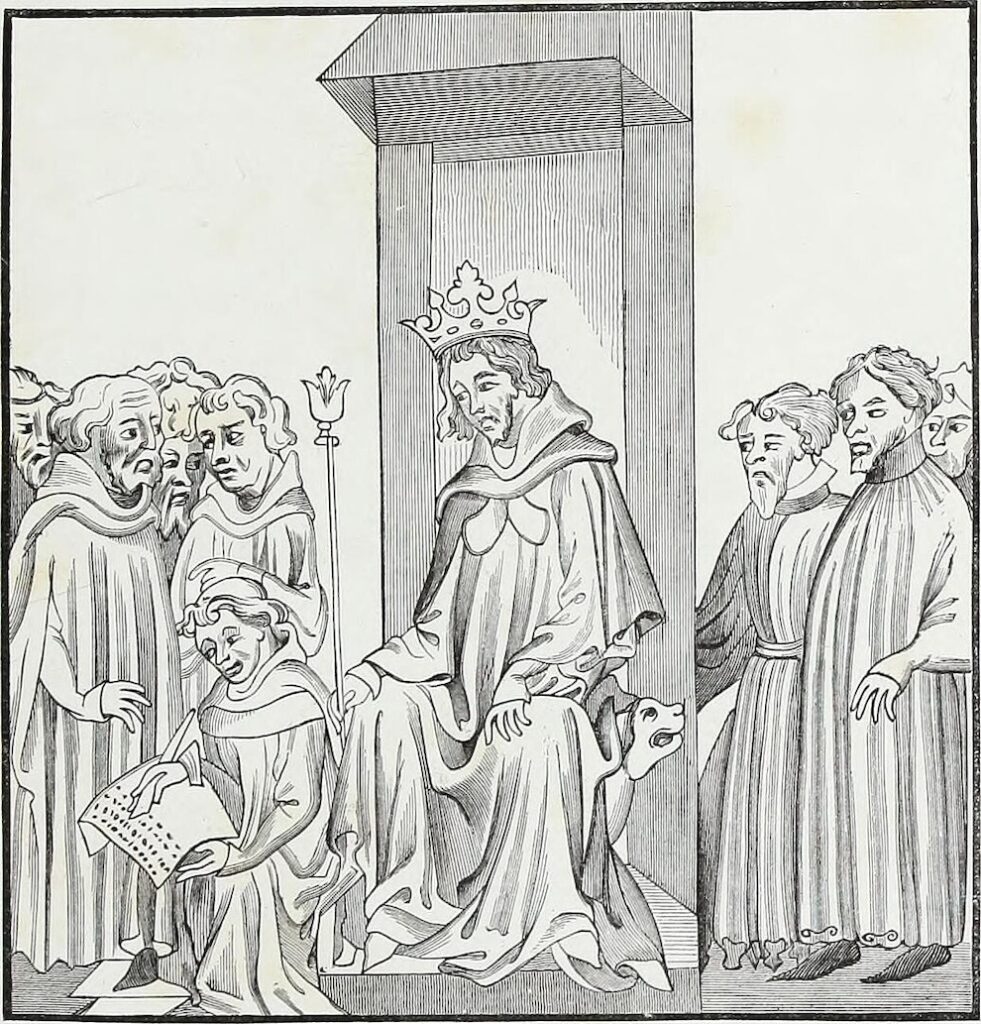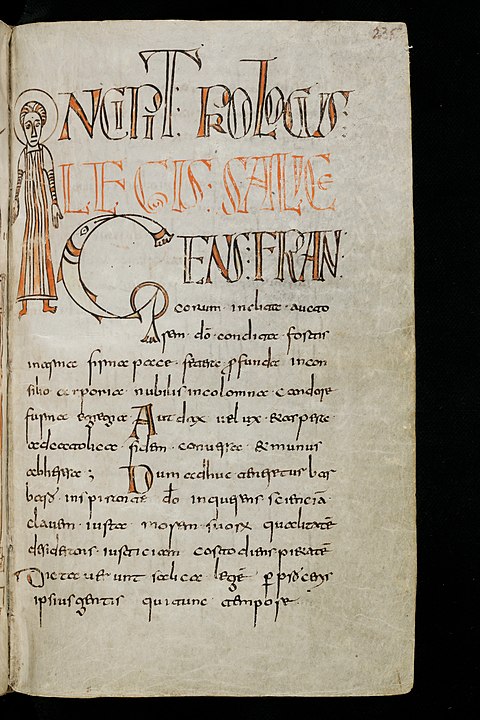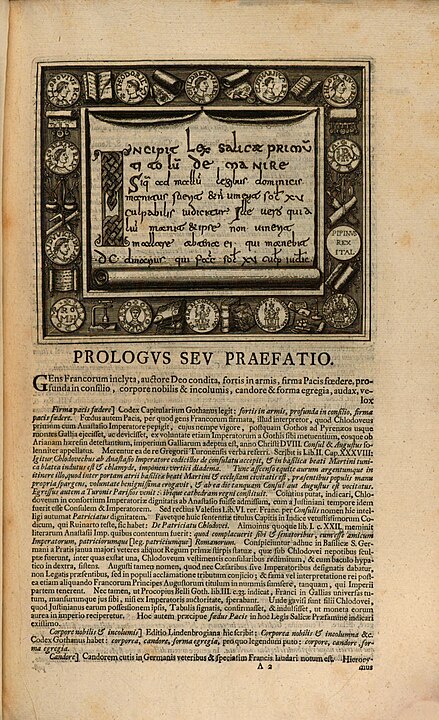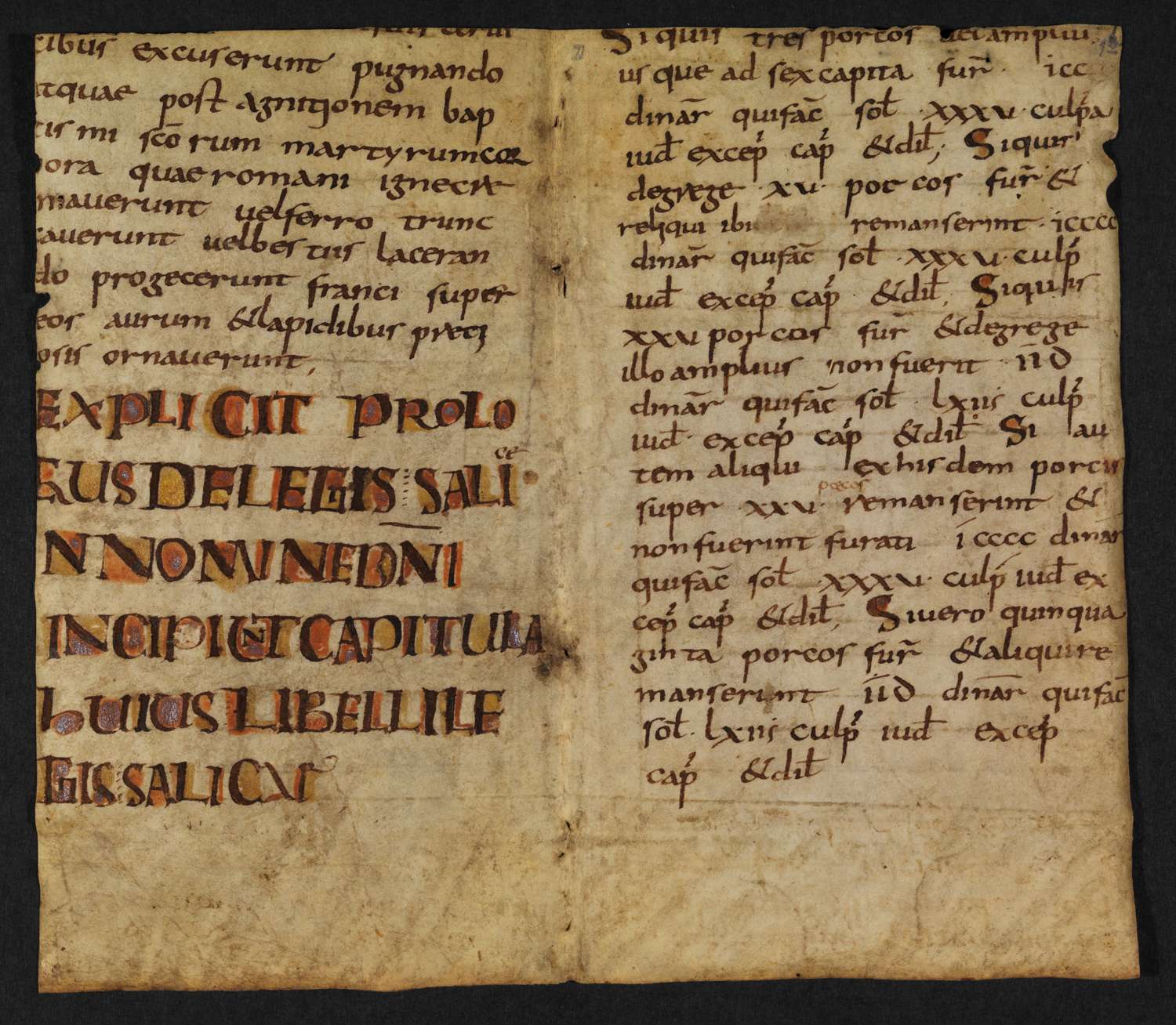The Salic Law, likely dating back to the 4th century, is a legal code established by the Salian Franks under Roman influence. Initially aimed at ending the practice of revenge in cases of crime, it replaced allowing the victim’s family to seek justice by obliging the offender to pay a fine.
The code also outlines rules for the inheritance of property. Originally transmitted orally, the Salic Law was later put into writing during the reign of Clovis and underwent revisions during the Carolingian era.
During the Merovingian period, the Kingdom of France always passed to male heirs, excluding women from succession. This rule is not explicitly stated in the Salic Law, which does not address the rules of the French crown’s inheritance.
Nevertheless, the text, rediscovered by Richard Lescot in the 14th century, was invoked to counter the claims of the English king to the French throne during the Hundred Years’ War. Since then, it has become synonymous with “agnatic primogeniture,” or the “exclusive succession of the eldest male heir closest in the male line.”
—>Agnatic succession, as defined by Salic Law, is a system of inheritance and succession that prioritizes the male line of descent. In other words, inheritance and succession follow the male bloodline, excluding female descendants from the direct line of succession.
Who Created the Salic Law?

The Salic Law was established in the early 6th century by the Salian Franks, a Germanic people who were part of the Frankish League. However, it is likely that this legal code was transmitted orally as early as the 4th century. The Salian Franks inhabited the region near the mouth of the Rhine. In the 5th century, King Clodion the Hairy founded a small kingdom with its capital in Tournai, in present-day Belgium. In 481 or 482, Clovis inherited the kingdom. It was during this period that the Pactus Legis Salicae, the code known as the “Salic Law,” was composed.
The text derives its name from the people who implemented it. It mentions the names of the law’s authors, who were the Frankish leaders Arogast, Salegast, Visogast, and Windogast. In the 8th century, the code underwent revisions during the reigns of Pepin the Short and Charlemagne. The Salic Law fell into obscurity for several centuries, and it wasn’t until 1358 that a monk named Richard Lescot rediscovered the text in the archives of the monastery of Saint-Denis.
What Was the Salic Law About?
The text, written during the reign of Clovis, was a code of criminal and civil law aimed at resolving disputes between families. It essentially outlines the tariffs for compensating the injured party in cases of murder, mutilation, or theft. Originally composed in Latin, the first version of the Salic Law is divided into 65 titles, each consisting of a specific number of articles. Over the centuries, new articles are added to the legal code, reaching 100 articles under Charlemagne. The various titles cover:
The text, written during the reign of Clovis, constitutes a code of criminal and civil law designed to settle disputes between families. It essentially delineates the tariffs for compensating the injured party in cases of murder, mutilation, or theft. Originally composed in Latin, the initial version of the Salic Law was categorized into 65 titles, each comprising a specific number of articles. Over the centuries, additional articles were incorporated into the legal code, culminating in 100 articles under Charlemagne. The diverse titles encompass:
- Procedures for summoning (an individual refusing to appear was outlawed, and their property confiscated).
- Theft of animals.
- Theft of trees.
- Abduction of a slave or servant.
- Theft of objects and break-ins.
- Robbing of corpses.
- Injuries.
- Murders.
- Adulterous relationships.
- Mutilations.
- Insults.
- Calumnies.
- Transmission of property.
The code was particularly detailed regarding the theft of animals. For instance, it specified that stealing a pig that has reached one year of age was punishable by a fine of 120 deniers or 3 gold sous, in addition to the value of the animal and prosecution expenses.
Notably, the code does not specify succession rules for the throne. The version drafted under Clovis states that women can inherit from men. In the Carolingian era, the concept of “Salic land” emerged in the article De alodis, which declares that “all inheritance of the land passes to the male sex.” However, the text does not precisely define what Salic land entails.
—>Salic Law, in its historical form, is not directly relevant to contemporary legal systems. However, its influence on medieval legal thought has left a lasting impact on the development of inheritance laws and succession practices in Europe. Some principles related to gender-based inheritance restrictions have persisted in certain regions.
What Was the Purpose of the Salic Law?

The Salic Law aimed to put an end to the blood feud. Among the Germanic tribes, the blood feud was a tradition of private vengeance. When a crime such as murder, theft, rape, or mutilation occurred, the victim’s family had the right to seek revenge on the offender’s family. Often, one murder led to another in this cycle of retaliation. This system was prevalent among Germanic peoples, including the Franks.
Historians suggest that the Franks established an oral pact with the Romans as early as the 4th century to replace the blood feud with monetary fines. The Franks, like other groups, were integrated into the Roman Empire as Laeti (an intermediate status between freedom and servitude).
The Romans enforced their legal system, which aimed to maintain public order. The substitution of familial vengeance with fines was a method to replace private justice with public justice, in accordance with Roman law. The Salic Law thus formalizes the concept that legitimate violence falls under the jurisdiction of the public authority. Subsequently, the Franks retained these rules inherited from the Romans.
How Did the Carolingians Transform Salic Law?
The Salic Law, drafted during the time of Clovis (around 510), specifies that the inheritance of property occurs through the parents, disregarding the gender of the inheritor. “If any man die and leave no sons, if the father and mother survive, they shall inherit.If the father and mother do not survive, and he leave brothers or sisters, they shall inherit.“
The legal code underwent revision in 763–764, during the reign of Pepin the Short, the founder of the Carolingian dynasty. It expands from 65 to 100 articles, adopting the name “Terra salica,” introducing the concept of “Salic land,” which cannot be transmitted to women: “But of Salic land no portion of the inheritance shall come to a woman: but the whole inheritance of the land shall come to the male sex.”
The exact meaning of the term “Salic land” is yet to be firmly established. Some historians speculate it refers to the realm of the Salian Franks, while others suggest it pertains to lands granted by the Romans to Frankish leaders in exchange for military service. Indeed, the Romans believed that these lands assigned to men should remain the property of men available for Roman military service.
Around the year 800, Charlemagne commissioned a new version of the Salic Law, titled “Lex Reformata,” or “Lex Salica Emendata.” The text is then reduced to 70 titles, with the title De alodis, concerning the inheritance of property, remaining unchanged.
Did the Salic Law Lead to the Hundred Years’ War?

During the Merovingian dynasty, the kingdom was divided among the sons of the deceased king. The Capetians put an end to this practice, establishing the primogeniture principle, where the crown passes to the eldest son. Daughters were consistently excluded from succession to prevent the French throne from falling into the hands of a foreign prince.
Traditionally, the daughters of a king would marry a prince from another realm. Nevertheless, the Salic law was not cited to justify the exclusion of women, as the text had fallen into obscurity from the 9th century onward.
In 1316, the king of France, Louis X, son of Philip IV the Fair (Philip VI of France), died without a male heir. His brothers, Philip V and then Charles IV, succeeded him but also died without offspring. Ultimately, it was Philip VI, the nephew of Philip IV, who ascended to the throne. In 1327, Edward III became the king of England.
As the grandson of Philip IV through his mother, he claimed the French crown in 1337. For the French, allowing a foreigner to ascend the throne of France was out of the question, especially since women could not transmit a right they did not possess. This marked the beginning of the Hundred Years’ War.
In 1358, the monk Richard Lescot rediscovered a manuscript of the Salic law in the archives of the Abbey of Saint-Denis. He then used the title “De alodis” to prove that England’s claims were illegitimate. Under the reign of Charles V, the rules for the devolution of the French crown were definitively established: solely through male dynastic transmission, by election, or by lineage election.
Did Francis I Become King Thanks to the Salic Law?

From the 14th century on, the Salic law became the reference in the succession to the French throne. It was, in fact, applied during the succession of Louis XII, who passed away in 1515. From his first marriage to Joan of France, he had no children. From his union with Anne of Brittany, two daughters survived.
The elder, Claude of France, married her cousin Francis from the Valois-Orléans-Angoulême branch. It was Francis who inherited the kingdom of France under the name Francis I. Francis I and Claude de France gave birth to Henry II, who ascended to the throne in 1547.
How Did the Salic Law Bring Henry IV to the Throne?
The Salic Law was reinstated in 1589 when the King of France, Henry III, was assassinated by the monk Jacques Clément. With his death, the Valois dynasty came to an end. Henry III, like his predecessors, Francis II and Charles IX, died without offspring. According to the Salic Law, Henri de Navarre, the first prince of the blood, was to succeed him.
Indeed, he was a direct male descendant of King Louis IX of France (Saint Louis), spanning ten generations. Despite being a Protestant, Henry IV of France was despised by Catholics who preferred to see the crown bestowed upon the Cardinal de Bourbon or Isabelle of Spain, the granddaughter of Henry II.
The Catholic League even invoked a law stating that the King of France must be Catholic. Nevertheless, it was unequivocally Henry IV of France whom Henry III, before his demise, acknowledged as his successor. In 1589, Henry IV of France ascended to the throne of France, assuming the title of Henry IV.






